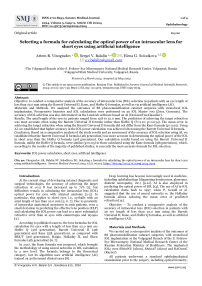Selecting a formula for calculating the optical power of an intraocular lens for short eyes using artificial intelligence
Автор: Artem R. Vinogradov, Sergei V. Balalin, Elena G. Solodkova
Журнал: Saratov Medical Journal @sarmj
Статья в выпуске: 2 Vol.5, 2024 года.
Бесплатный доступ
Objective: to conduct a comparative analysis of the accuracy of intraocular lens (IOL) selection in patients with an eye length of less than 22.0 mm using the Barrett Universal II, Kane, and Hoffer Q formulas, as well as via artificial intelligence (AI). Materials and Methods. We analyzed the outcomes of 88 phacoemulsification cataract surgeries with monofocal IOL implantation. Preoperative biometry and IOL calculations were performed on an IOL Master 700 (Zeiss, Germany). The accuracy of IOL selection was also determined via the LensCalc software based on AI (DecisionTreeClassifier). Results. The axial length of the eyes in patients ranged from 19.8 to 22.0 mm. The prediction of achieving the target refraction was most accurate when using the Barrett Universal II formula rather than Hoffer Q (Z=2.12; p=0.034). The mean error in achieving the target refraction when using the Barrett Universal II formula did not differ from the Kane formula (p>0.05). Using AI, we established that higher accuracy in the IOL power calculation was achieved when using the Barrett Universal II formula. Conclusion. Based on a comparative analysis of the study results and an assessment of the accuracy of IOL selection using AI, we established that the Barrett Universal II formula (4th generation) was more accurate in determining the optical power of the IOL in short eyes than the Hoffer Q formula (3rd generation). Our calculation results based on using the Barrett Universal II formula, unlike the Hoffer Q formula, were similar (p>0.05) to those calculated using the Kane formula (5th generation), which, according to the results of the majority of published studies, is currently the most accurate formula for IOL selection.
IOL power calculation, short eyes, artificial intelligence
Короткий адрес: https://sciup.org/149147114
IDR: 149147114 | DOI: 10.15275/sarmj.2024.0204
Список литературы Selecting a formula for calculating the optical power of an intraocular lens for short eyes using artificial intelligence
- Cheng H, Kane JX, Liu L, et al. Refractive predictability using the IOLMaster 700 and artificial intelligence–based IOL power formulas compared to standard formulas. J Refract Surg. 2020; 36 (7): 466-72. https://www.doi.org/10.3928/1081597X-20200514-02
- Su PF, Lo AY, Hu CY, Chang SW. Anterior chamber depth measurement in phakic and pseudophakic eyes. Optom Vis Sci. 2008; 85 (12): 1193-2000. https://www.doi.org/10.1097/OPX.0b013e31818e8ceb
- IOL calculation in patients with hypermetropia. New in Ophthalmology 2014; 3: 64-5. (In Russ.).
- Egorova EV, Malyugin BE, Morozova TA, Polyanskaya EG. Anatomical and topographic features of the pseudophakic eye anterior segment based on the results of a study using ultrasound biomicroscopy. Cataract and Refractive Surgery 2010; 4: 12-6. (In Russ.).
- Pershin KB, Pashinova NF, Tsygankov AYu, Legkikh SL. Features of calculating the optical power of IOL in patients with an axial length of the eye of 24-28 mm without previous refractive interventions. Ophthalmology 2016; 13 (2): 89-96. (In Russ.). https://www.doi.org/10.18008/1816 5095 2016 2 89 96
- Pershin KB, Pashinova NF, Lih IA, Tsygankov AYu. Comparative analysis of the accuracy of intraocular lens calculation using seven formulas in eyes with an axial length of less than 20.00 mm. Modern Technologies in Ophthalmology 2021; 1 (36): 57-61. (In Russ.). https://www.doi.org/0.25276/2312-4911-2021-1-57-61
- Pershin KB, Pashinova NF, Likh IA, Tsygankov AYu. Analysis of the accuracy of six formulas for calculating the optical power of intraocular lenses in eyes with an axial length of 20-22 mm. Saratov Journal of Medical Scientific Research 2020; 16 (2): 638-42. (In Russ.).
- Kane Formula. URL: https://www.iolformula.com/about/ (15 Feb 2024).
- Malyugin BE, Sakhnov SN, Aksenova LE. Using machine learning methods in developing a keratoconus diagnostic algorithm. Bulletin of St. Petersburg State University of Technology and Design. Series 1. Natural Sciences and Technology 2022; (1): 79-86. (In Russ.). https://www.doi.org/10.46418/2079-8199_2022_1_12
- Malyugin BE, Sakhnov SN, Myasnikova VV, Aksenova LE. Using artificial intelligence in in keratoconus diagnostics and surgery: A systematic review. Fyodorov Journal of Ophthalmic Surgery 2022; (1): 77-96. (In Russ.). https://www.doi.org/10.25276/0235-4160-2022-1-77-96
- Kuroyedov AV, Ostapenko GA, Mitroshina KV, Movsisyan AB. State-of-the-art diagnostics of glaucoma: Neural networks and artificial intelligence. Russian Journal of Clinical Ophthalmology 2019; 19 (4): 230-7. (In Russ.). https://www.doi.org/10.32364/2311-7729-2019-19-4-230-237
- Dobrov ER. Using neural networks in the diagnosis of diabetic retinopathy. Models, Systems, Networks in Economics, Technology, Nature and Society 2022; (2): 90-105. (In Russ.). https://www.doi.org/10.21685/2227-8486-2022-2-7
- Xia T, Martinez CE, Tsai LM. Update on intraocular lens formulas and calculations. Asia Pac J Ophthalmol (Phila). 2020; 9 (3): 186-93. https://www.doi.org/10.1097/APO.0000000000000293
- Clarke GP, Burmeister J. Comparison of intraocular lens computations using a neural network versus the Holladay formula. J Cataract Refract Surg. 1997; 23 (10): 1585-9. https://www.doi.org/10.1016/s0886-3350(97)80034-x
- Arzamastsev AA, Fabrikantov OL, Zenkova NA, Belikov SV. Intraocular lens (IOL) calculation in ophthalmology using artificial intelligence models. In: Current Issues in Applied Mathematics, Computer Science and Mechanics: Proceedings of the International Scientific Conference 2021. Voronezh: Welborn, 2022; p. 291-6. (In Russ.).
- Melles RB, Holladay JT, Chang WJ. Accuracy of intraocular lens calculation formulas. Ophthalmology 2018; 125 (2): 169-78. https://www.doi.org/10.1016/j.ophtha.2017.08.027
- Siddiqui AA, Juthani V, Kang J, Chuck RS. The future of intraocular lens calculations: Ladas Super Formula. Ann Eye Sci. 2019; (4): 19. https://www.doi.org/10.21037/aes.2019.04.02
- Davidorf JM. Accuracy of Ladas Super Formula. URL: https://ascrs.org/clinical-education/abstracts/2018/accuracy-of-ladas-super-formula (15 Feb 2024).


